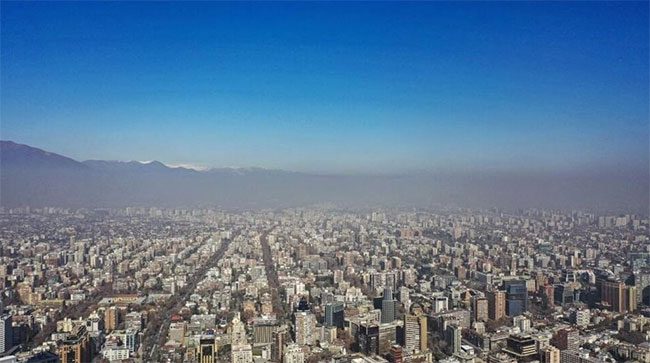Far from the harsh summer regions of the Northern Hemisphere, South American countries are still experiencing record heat waves even in the midst of winter.
On August 1, the mountain town of Vicuña in Central Chile reached 37 degrees Celsius. Chilean meteorologist Cristobal Torres stated that this is the first time in 70 years that a record warm winter phenomenon has occurred in Vicuña.
Unusually high temperatures were also recorded in the capital region of Santiago, located 450 km to the south, with temperatures reaching 24 degrees Celsius on August 2.

High temperatures lead to fog in the capital Santiago of Chile. (Photo: AFP).
Meanwhile, the National Meteorological Agency of Argentina reported that in the capital Buenos Aires, temperatures on August 1 exceeded 30 degrees Celsius, marking it as the hottest August 1 in historical records, as well as the first time since 2014 that winter temperatures in the Southern Hemisphere have surpassed 30 degrees Celsius.
The average temperature in Buenos Aires during August typically ranges from 9 to 18 degrees Celsius.
Several cities across Uruguay also recorded temperatures of 30 degrees Celsius on August 2.
“What we are experiencing is a combination of two phenomena: global warming due to climate change combined with the El Niño phenomenon“, said Chile’s Minister of the Environment, Maisa Rojas.
Ms. Rojas predicted that once El Niño ends, the global weather situation will not be as extreme.
The El Niño weather pattern, characterized by rising sea surface temperatures in the Pacific Ocean, has caused rain, flooding, and avalanches in the southwestern part of South America, as well as extreme heat waves.
Forecasts indicate that Santiago, Buenos Aires, and Montevideo will return to normal temperatures in the coming days, but scientists believe that similar heat waves will occur with increasing frequency.
Climate scientist Raul Cordero from the University of Santiago explained: “It is likely that temperature records will be broken this year (in Santiago) and that is extremely unusual. Ten years ago, we had 2 heat waves each year, and now we are talking about 9 each year.”
One of the most significant impacts of warm weather is the melting of snow and ice layers in the mountains, which are vital for water supply in the capital of Chile.
“Winter heat waves are devastating glaciers and snow,” expert Cordero remarked.
Environment Minister Maisa Rojas also warned about the impact of heat at both the North and South Poles.
“The ice surrounding the polar regions is at a minimum. Particularly around Antarctica, where at this time of year, sea ice typically reaches its maximum level by September, it is currently at a historical minimum,” Ms. Rojas noted.
According to Cindy Fernández, spokesperson for Argentina’s National Meteorological Agency, the central and northern regions of Argentina are experiencing hot weather patterns, with temperatures 10 to 15 degrees Celsius higher than what is typically recorded for this time of year in winter. In other words, Ms. Fernández suggested that Argentina is experiencing a warmer winter.
Currently, heat waves are engulfing many countries around the world, affecting the lives and daily activities of the people. According to a team of scientists from World Weather Attribution – an organization specializing in assessing the role of climate change in extreme weather patterns globally, these weather phenomena would “rarely occur” without human-induced climate change.


















































